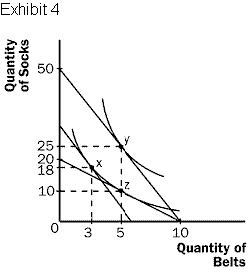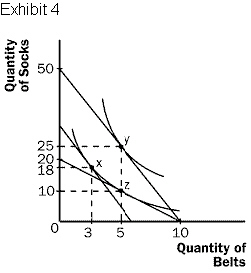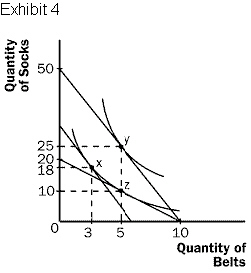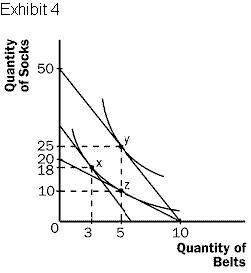True/False
Indicate whether the
sentence or statement is true or false.
|
|
|
1.
|
If we measure the quantity of French fries on the
horizontal axis and the quantity of hamburgers on the vertical axis, and if the price of French fries
is €0.60 and the price of a hamburger is €2.40, then the slope of the budget constraint
is 1/4 (and it is negative).
|
|
|
2.
|
A budget constraint is a set of commodity bundles
that provide the consumer with the same level of satisfaction.
|
|
|
3.
|
Indifference curves measure the consumer's
willingness to trade one good for another good while maintaining a constant level of
satisfaction.
|
|
|
4.
|
When drawn on a graph that measures the quantity of
a good on each axis, indifference curves are usually straight lines that slope downward
(negatively).
|
|
|
5.
|
If two goods are perfect complements, indifference
curves associated with these two goods would cross each other at the optimum.
|
|
|
6.
|
Indifference curves tend to be bowed inward because
a consumer is willing to trade a greater amount of a good for another if they have an abundance of
the good they are trading away.
|
|
|
7.
|
At the consumer's optimum point, the marginal
rate of substitution of apples for oranges is equal to the ratio of the price of oranges to the price
of apples.
|
|
|
8.
|
The more difficult it is to substitute one good for
another, the more bowed inward indifference curves become.
|
|
|
9.
|
If the price of a good falls, the substitution
effect always causes an increase in the quantity demanded of that good.
|
|
|
10.
|
If the price of a good falls and the good is a
normal good, the income effect causes a decrease in the quantity demanded of that good.
|
|
|
11.
|
If the price of a good falls and the good is an
inferior good, the income effect causes a decrease in the quantity demanded of that
good.
|
|
|
12.
|
The income effect is measured as the change in
consumption that results when a price change moves the consumer along a given indifference curve to a
point with a new marginal rate of substitution.
|
|
|
13.
|
An increase in the interest rate will always lead
to a greater amount of saving.
|
|
|
14.
|
A Giffen good is an extremely inferior
good.
|
|
|
15.
|
The theory of consumer choice can be used to
demonstrate that labour supply curves must be upward sloping.
|
Multiple Choice
Identify the
letter of the choice that best completes the statement or answers the question.
|
|
|
16.
|
The limit on the consumption bundles that a
consumer can afford is known as
a. | an indifference curve. | b. | the budget constraint. | c. | the marginal rate
of substitution. | d. | the consumption
limit. |
|
|
|
17.
|
A change in the relative prices of which of the
following pair of goods would likely cause the smallest substitution effect?
a. | right shoes and left shoes | b. | petrol from BP and petrol from Shell | c. | Kit-Kat chocolate snacks and Twix chocolate snacks | d. | Coke and Pepsi |
|
|
|
18.
|
Indifference curves for perfect substitutes
are
a. | right angles. | b. | bowed outward. | c. | straight
lines. | d. | nonexistent. | e. | bowed inward. |
|
|
|
19.
|
Suppose a consumer must choose between the
consumption of sandwiches and pizza. If we measure the quantity of pizza on the horizontal axis and
the quantity of sandwiches on the vertical axis, and if the price of a pizza is €10 and the
price of a sandwich is €5, then the slope of the budget constraint is
|
|
|
20.
|
The slope at any point on an indifference curve is
known as
a. | the marginal rate of
substitution. | b. | the marginal rate
of trade-off. | c. | the trade-off
rate. | d. | the marginal rate of
indifference. |
|
|
|
21.
|
Which of the following statements is not true with
regard to the standard properties of indifference curves?
a. | Indifference curves are downward
sloping. | b. | Indifference curves are bowed
outward. | c. | Indifference curves do not cross each
other. | d. | Higher indifference curves are preferred to lower
ones. |
|
|
|
22.
|
The consumer's optimal purchase of any two
goods is the point where
a. | the budget constraint crosses the indifference
curve. | b. | the two highest indifference curves
cross. | c. | the consumer reaches the highest indifference curve
subject to remaining on the budget constraint. | d. | the consumer has
reached the highest indifference curve. |
|
|
|
23.
|
Which of the following is true about the
consumer's optimum consumption bundle? At the optimum,
a. | the slope of the indifference curve equals the slope of
the budget constraint. | b. | the indifference
curve is tangent to the budget constraint. | c. | the relative
prices of the two goods equals the marginal rate of substitution. | d. | none of these answers are true. | e. | all of these answers are true. |
|
|
|
24.
|
Suppose we measure the quantity of good X on the
horizontal axis and the quantity of good Y on the vertical axis. If indifference curves are bowed
inward, as we move from having an abundance of good X to having an abundance of good Y, the marginal
rate of substitution of good Y for good X (the slope of the indifference curve)
a. | rises. | b. | stays the same. | c. | could rise or fall
depending on the relative prices of the two goods. | d. | falls. |
|
|
|
25.
|
If an increase in a consumer's income causes
the consumer to increase his quantity demanded of a good, then the good is
a. | a complementary good. | b. | an inferior good. | c. | a normal
good. | d. | a substitute
good. |
|
|
|
26.
|
If an increase in a consumer's income causes
the consumer to decrease her quantity demanded of a good, then the good is
a. | a substitute good. | b. | a normal good. | c. | a complementary
good. | d. | an inferior good. |
|
|
|
27.
|
 Refer to Exhibit 4. Suppose that the consumer must choose between buying socks
and belts. Also, suppose that the consumer's income is €100. If the price of a belt is
€10 and the price of a pair of socks is €5, the consumer will choose to buy the commodity
bundle represented by point Refer to Exhibit 4. Suppose that the consumer must choose between buying socks
and belts. Also, suppose that the consumer's income is €100. If the price of a belt is
€10 and the price of a pair of socks is €5, the consumer will choose to buy the commodity
bundle represented by pointa. | Z | b. | X | c. | Y | d. | the optimal point
cannot be determined from this graph. |
|
|
|
28.
|
 Refer to Exhibit 4. Suppose that the consumer must choose between buying socks
and belts. Also, suppose that the consumer's income is €100. Suppose that the price of a
pair of socks falls from €5 to €2. The substitution effect is represented by the movement
from point Refer to Exhibit 4. Suppose that the consumer must choose between buying socks
and belts. Also, suppose that the consumer's income is €100. Suppose that the price of a
pair of socks falls from €5 to €2. The substitution effect is represented by the movement
from pointa. | Z to point X. | b. | X to point Y. | c. | X to point
Z. | d. | Y to point X. |
|
|
|
29.
|
 Refer to Exhibit 4. Suppose that the consumer must choose between buying socks
and belts. Also, suppose that the consumer's income is €100. Suppose that the price of a
pair of socks has falls from €5 to €2. The income effect is represented by the movement
from point Refer to Exhibit 4. Suppose that the consumer must choose between buying socks
and belts. Also, suppose that the consumer's income is €100. Suppose that the price of a
pair of socks has falls from €5 to €2. The income effect is represented by the movement
from pointa. | X to point Y. | b. | X to point Z. | c. | Y to point
X. | d. | Z to point X. |
|
|
|
30.
|
 Refer to Exhibit 4. Suppose that the consumer must choose between buying socks
and belts. Also, suppose that the consumer's income is €100. A pair of socks
is Refer to Exhibit 4. Suppose that the consumer must choose between buying socks
and belts. Also, suppose that the consumer's income is €100. A pair of socks
isa. | an inferior good. | b. | a Giffen good. | c. | a normal
good. | d. | none of these
answers. |
|
|
|
31.
|
The change in consumption that results when a price
change moves the consumer along a given indifference curve is known as the
a. | inferior effect. | b. | normal effect. | c. | substitution
effect. | d. | complementary effect. | e. | income effect. |
|
|
|
32.
|
If income were to double and prices were to double,
the budget line would
a. | stay the same. | b. | rotate inward. | c. | shift outward in a
parallel fashion. | d. | rotate
outward. | e. | shift inward in a parallel
fashion. |
|
|
|
33.
|
If leisure is a normal good, an increase in the
wage
a. | will always increase the quantity of labour
supplied. | b. | will increase the amount of labour supplied if the
substitution effect outweighs the income effect. | c. | will increase the amount of labour supplied if the income effect outweighs the
substitution effect. | d. | will always
decrease the amount of labour supplied. |
|
|
|
34.
|
If consumption when young and when old are both
normal goods, an increase in the interest rate
a. | will always increase the quantity of
saving. | b. | will always decrease the quantity of
saving. | c. | will increase the quantity of saving if the substitution
effect outweighs the income effect. | d. | will increase the
quantity of saving if the income effect outweighs the substitution
effect. |
|
|
|
35.
|
Which of the following is not true regarding the
outcome of a consumer's optimization process?
a. | The marginal utility per dollar spent on each good is
the same. | b. | The marginal rate of substitution between goods is equal
to the ratio of the prices between goods. | c. | The
consumer's indifference curve is tangent to his budget constraint. | d. | The consumer has reached his highest indifference curve subject to his budget
constraint. | e. | The consumer is
indifferent between any two points on his budget constraint. |
|